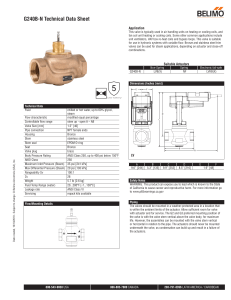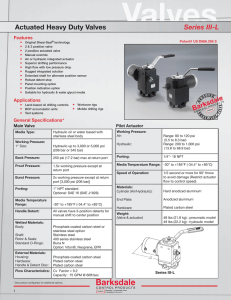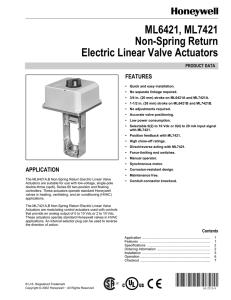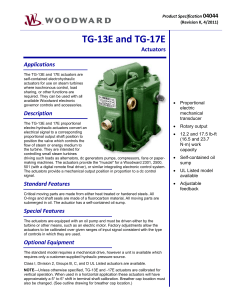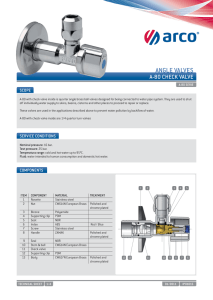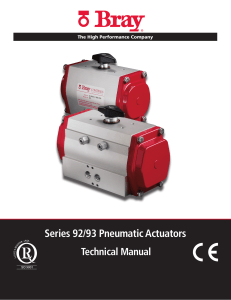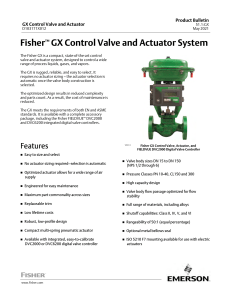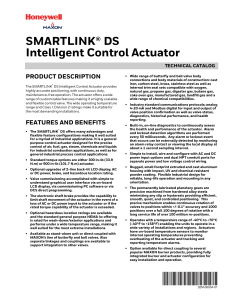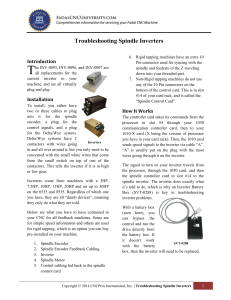E671E ROM_RBM English.indd
Anuncio
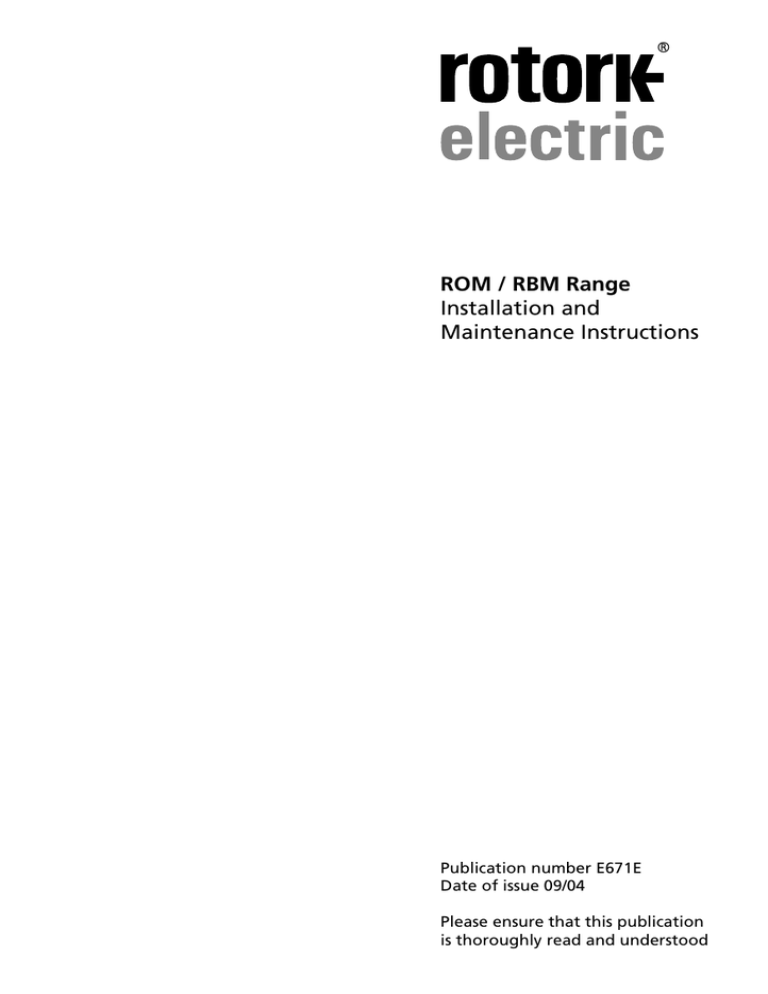
ROM / RBM Range Installation and Maintenance Instructions Publication number E671E Date of issue 09/04 Please ensure that this publication is thoroughly read and understood Contents page 1 2 3 4 5 6 7 8 2 Health and Safety Important Notices and Maintenance Lubrication Set Mechanical Stops Travel Cam and Limit Switches Adjustment Potentiometer Trouble Shooting Wiring Diagram 3 3 4 4 5 8 9 10 1 - Health and Safety This manual is produced to enable a competent user to install, operate, adjust and inspect Rotork ROM/RBM range valve actuators. The electrical installation, maintenance and use of these actuators should be carried out in accordance with the National Legislation and Statutory Provisions relating to the safe use of this equipment, applicable to the site of installation. For the UK: Electricity at Work Regulations 1989 and the guidance given in the applicable edition of the ‘IEE Wiring Regulations’ should be applied. Also the user should be fully aware of his duties under the Health and Safety Act 1974. For the USA: NFPA70, National Electrical Code® is applicable. The mechanical installation should be carried out in accordance with relevant standards such as British Standard Codes of Practice. Only persons competent by virtue of their training or experience should be allowed to install, maintain and repair Rotork actuators. Work undertaken must be carried out in accordance with instructions in the manual. The user and those persons working on this equipment should be familiar with their responsibilities under any statutory provisions relating to the health and safety of their workplace. Where appropriate the user must ensure the actuator is suitably protected against its operating environment. Should further information and guidance relating to the safe use of the Rotork ROM/RBM range of actuators be required, contact Rotork. If your actuator cannot be installed immediately, store it in a dry place until you are ready to connect incoming cables. If the actuator has to be installed but cannot be cabled it is recommended that the plastic transit cable entry plugs are replaced with metal plugs which are sealed with PTFE tape. Rotork cannot accept responsibility for deterioration caused on site once the covers are removed. WARNING With respect to handwheel operation of Rotork electric actuators, under no circumstances should any additional lever device such as a wheel-key or wrench be applied to the handwheel in order to develop more force when closing or opening the valve as this may cause damage to the valve and/or actuator or may cause the valve to become stuck in the seated/backseated position. 2 - Important Notices and Maintenance NOTICES: 1 - Make sure the voltage is correct before wiring. 2 - Turn off before power for maintenance purposes. 3 - Seal the casing and conduit entrance after wiring to prevent dusting or water contamination. 4 - The angle of electric actuator installation must be between 0~180 degree. Do not install upside down or below the horizontal. 5 - Do not install when hazardous or explosive gases may be present. 6 - The frequency of open and close is restricted to every 5 minutes. Avoid too high frequency. 7 - When more than one electric actuator needs to operate simultaneously, please connect with the individual cables. 8 - Please connect the ground wire to PE inside the electric actuator. 9 - The warranty period of our product is for one year. 3 3 - Lubrication The gearbox of the ROM/RBM actuators is enclosed, and it has already been lubricated sufficiently with high temperature lubricant at the factory sufficient for use for up to two years. 4 - Setting Mechanical Stops (1) For Electric Operation Please refer to “Travel Cam & Limit Switches Adjustment”. 4 (2) 1. 2. 3. 4. For Manual Operation Loosen the screws. Adjust limit switches & travel cams. Adjust the screws. Reverse one cycle. 5 - Travel Cam & Limit Switches Adjustment The travel cams are set to control the open and closed position of the valve. The position is set to stop the travel of the actuator when the travel cams activate the limit switch. Standard is two limit switches, one for open, one for closed. The bottom limit switch is normally the open position (full CCW); the top limit switch is normally the closed position (full CW). 2-Auxiliary switches are available and are set independent of the two primary control limit switches. The travel cams can be adjusted by 2.5mm Hex. Spanner. Both CAM & switches should be checked and if necessary adjusted for correct operation. On setting switches / cams, correct electrical operation of the switch should be established. Failure to check / set both switch and cam could result in switches not being made and the actuator failing to stop. 5 5 - Travel Cam & Limit Switches Adjustment cont. 6 5 - Travel Cam & Limit Switches Adjustment cont. 7 6 - Potentiometer Potentiometers turn with transmission shafts, and can provide a feedback signal for position indication. Potentiometer points 1, 2, 3 are wired to terminal blocks 5, 6, 7. When a valve is closed: 5, 6 1K Ohm 6, 7 0K Ohm When a valve is opened: 5, 6 0K Ohm 6, 7 1K Ohm For modulating controllers, potentiometer points 1, 2, 3 are wired to terminal blocks 8, 9, 10. When a valve is closed: 8, 9 5K Ohm 9, 10 0K Ohm When a valve is opened: 8, 9 0K Ohm 9, 10 5K Ohm * Note: ROM-A is opposite. (i.e. 1,2,3 wired to 7,6,5; 1,2,3 wired to 10,9,8) 8 7 - Trouble Shooting Conditions Possibilities Solutions Motor does not operate. 1. Is the supplied power and voltage correct? 2. Any blisters on the capacitor? 3. Are the gear trains free? 1. Check supply. 2. If so replace. 3. Remove motor to check Motor stops running. 1. Is power supply short circuited? 2. Any foreign objects in flow stream? 1. Check wiring 2. Check for obstructions Unable to fully open/close. 1. Loose/Misaligned cam? 2. Bent valve stem? 3. Mechanical stop adjustment incorrect? 1. Adjust/Tighten using spanner. 2. Replace valve stem 3. Check position of stops Valve stops operating when motor is running. 1. Gear worn out? 2. Sleeve adaptor worn out or broken? 3. Broken valve stem or actuator transmission shaft? 1. Replace gear. 2. Replace sleeve adaptor. 3. Replace valve stem or actuator transmission shaft. Abnormal control for operating two or more actuators simultaneously. 1. Controlling circuit connects in tandem or parallel? 1. Please refer to the wiring diagram. Motor overheats. 1. Is the voltage correct? 2. Is valve too tight to operate? 3. High working frequency? 4. Is motor stem or bearing binding? 1. 2. 3. 4. Abnormal on/off angle on 3-phase voltage. 1. Wrong phase wiring? 1. Change phase wiring. Occasional on/off actuator failure. 1. Simultaneous input power on/off. 1. Check if the selection switch is normal. Vibration when valve is closed. 1. Motor brake spring fatigued or Teflon worn? 1. Replace spring or Teflon. Check with meter. Replace valve. Check duty-cycle. Replace the binding parts. 9 8 - Wiring Diagram 10 11 UK head office Rotork Controls Limited telephone Bath 01225 733200 telefax 01225 333467 email [email protected] A full listing of our worldwide sales and service network is available on our website at www.rotork.com USA head office Rotork Controls Inc telephone Rochester (585) 328 1550 telefax (585) 328 5848 email [email protected] As part of a process of on-going product development, Rotork reserves the right to amend and change specifications without prior notice. Published data may be subject to change. For the very latest version release, visit our website at www.rotork.com Rotork Controls Ltd, Bath, UK Rotork Controls Inc, Rochester, USA The name Rotork is a registered trademark. Rotork recognizes all registered trademarks. Published and produced in the UK by Rotork Controls Limited.
